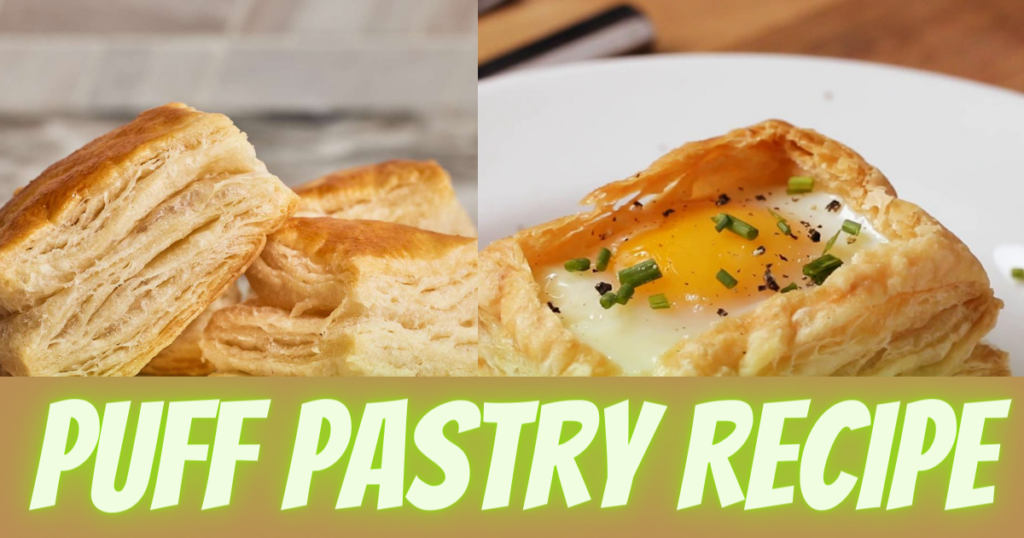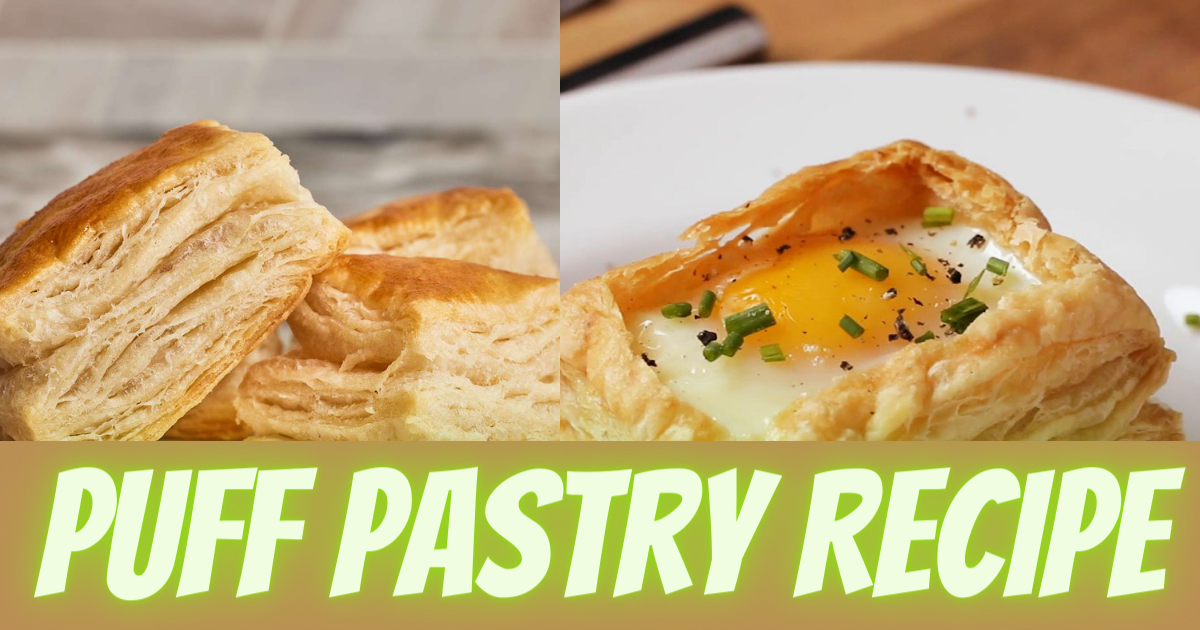Puff Pastry Recipe
If you’re a fan of light, flaky, and buttery pastries, then puff pastry is a must-try recipe! Puff pastry is a versatile dough that is used in a variety of sweet and savory dishes, such as croissants, turnovers, and palmiers. With its delicate layers that puff up during baking, puff pastry adds a touch of elegance and indulgence to any dish. In this article, we will delve into the world of puff pastry, learn how to make it from scratch, and explore some popular recipes and tips for success.

Introduction
Puff pastry is a classic French pastry known for its unique texture and rich flavor. It is made by layering butter and dough, then folding and rolling it multiple times to create thin layers. When baked, the butter melts and creates steam, which lifts the layers and creates the characteristic puffiness. The result is a light and airy pastry with a crispy and flaky texture that is perfect for a wide range of recipes.
What is Puff Pastry?
The origins of puff pastry can be traced back to ancient Egypt, where a similar dough made from layers of dough and fat was used to make flatbreads. However, the modern version of puff pastry, as we know it today, is credited to French pastry chefs who refined the technique in the 17th century. Since then, puff pastry has become a staple in French and European cuisine, and its popularity has spread to other parts of the world.
Ingredients for Puff Pastry
To make puff pastry from scratch, you will need the following ingredients:
- 2 cups all-purpose flour
- 1 teaspoon salt
- 1 cup cold unsalted butter, cut into small cubes
- 3/4 cup ice water
Note: Using high-quality butter is essential for the best results in making puff pastry, as it contributes to the flavor and texture of the final product.
Step-by-Step Guide to Making Puff Pastry
Making puff pastry requires some patience and practice, but the results are well worth it. Here is a step-by-step guide to making puff pastry from scratch:
Step 1: Mix the Flour and Salt In a large mixing bowl, whisk together the flour and salt until well combined. Step 2: Add the Butter Add the cold butter cubes to the flour mixture and toss to coat the butter with flour. Using a pastry cutter or your fingertips, cut the butter into the flour until it resembles coarse crumbs.
Step 3: Add the Water Gradually add the ice water to the flour mixture, one tablespoon at a time, and continue to mix with a fork until the dough comes together in a shaggy ball. Be careful not to overmix.
Step 4: Form the Dough Transfer the dough onto a lightly floured surface and gently shape it into a rough rectangle. Wrap it tightly in plastic wrap and refrigerate for at least 1 hour to allow the dough to rest and chill.
Step 5: Make the Turns Once the dough has chilled, it’s time to start making the turns. This process involves rolling out the dough and folding it in layers to create the puffiness. Here’s how to do it:
- Roll out the dough into a long rectangle, about 1/4 inch thick.
- Fold the top third of the dough down, then fold the bottom third up, like a letter.
- Turn the dough 90 degrees and roll it out again into a long rectangle.
- Fold and turn the dough two more times, for a total of three turns.
- Wrap the dough in plastic wrap and refrigerate for at least 30 minutes between each turn to keep the butter cold and firm.
Step 6: Use the Puff Pastry After the final turn, your puff pastry is ready to use! You can now roll it out into the desired thickness and shape for your recipe. Puff pastry can be used in a variety of sweet and savory recipes, such as pies, tarts, quiches, strudels, and more. Simply cut out the desired shapes, place them on a baking sheet, and bake in a preheated oven until golden and puffed.
Read more: Cheesecake Stuffed Strawberries
Tips for Making Perfect Puff Pastry
Making puff pastry can be challenging, but with some tips and tricks, you can achieve great results. Here are some tips for making perfect puff pastry:
1. Use cold ingredients: It’s crucial to keep the butter and water cold throughout the process to ensure that the layers of dough and butter don’t melt together.
2. Handle the dough gently: Avoid overmixing or overhandling the dough, as this can result in a tough texture. Be gentle when rolling out and folding the dough to maintain the layers.
3. Chill the dough between turns: Refrigerating the dough between turns allows the butter to firm up, making it easier to roll out and fold. It also helps create distinct layers in the final pastry.
4. Roll in one direction: When rolling out the dough, always roll in one direction to keep the layers even and prevent the dough from becoming too elastic.
5. Experiment with fillings: Puff pastry is incredibly versatile, so don’t be afraid to get creative with fillings. Try sweet or savory combinations, such as fruit, chocolate, cheese, or vegetables, to customize your puff pastry creations.
6. Bake in a hot oven: To achieve maximum puffiness, bake puff pastry in a hot oven (around 400°F/200°C) for the first 10-15 minutes, then lower the temperature for the remaining baking time to ensure that the layers cook and set properly.
Variations and Uses of Puff Pastry
Puff pastry is a versatile dough that can be used in a wide range of recipes. Here are some popular variations and uses of puff pastry:
1. Classic croissants: Croissants are a classic French pastry made with puff pastry dough that is rolled into a crescent shape and filled with butter or chocolate. They are a staple in French breakfasts and are also popular worldwide.
2. Palmiers: Palmiers, also known as elephant ears, are sweet pastries made by folding puff pastry into a palm-like shape and baking until crispy and caramelized. They are perfect for serving as a sweet treat or a tea-time snack.
3. Vol-au-vent: Vol-auvent is a classic French dish made with puff pastry shells that are filled with savory ingredients such as chicken, seafood, or mushrooms in a creamy sauce. It’s a delicious and elegant appetizer or main course option.
4. Fruit tarts: Puff pastry can be used as a base for fruit tarts, where it is baked until golden and crispy, then topped with fresh fruits and a glaze for a sweet and tart dessert.
5. Beef Wellington: Beef Wellington is a popular dish made with puff pastry, where a seared beef fillet is wrapped in puff pastry along with a layer of duxelles (mushroom mixture) and baked until golden and juicy. It’s a show-stopping dish often served for special occasions.
6. Cheese straws: Cheese straws are a popular appetizer or snack made with puff pastry, grated cheese, and spices. The puff pastry is rolled out, sprinkled with cheese and spices, then twisted and baked until crispy and cheesy.
7. Savory turnovers: Puff pastry can be used to make delicious savory turnovers filled with ingredients like spinach and feta, ham and cheese, or chicken and vegetables. These turnovers are perfect for a quick and easy meal or as party appetizers.
8. Napoleon pastry: Napoleon pastry, also known as mille-feuille, is a classic French dessert made with layers of puff pastry filled with pastry cream and topped with icing or powdered sugar. It’s a delicate and elegant dessert that requires precision in layering the puff pastry.
9. Chicken pot pie: Puff pastry can be used as a crust for chicken pot pie, where it’s baked until golden and flaky, and filled with a creamy chicken and vegetable filling. It’s a comfort food classic that’s perfect for cold weather.
10. Quiches: Puff pastry can be used as a crust for quiches, where it’s filled with eggs, cheese, vegetables, and meats to create a delicious and savory custard-based dish.
11. Pigs in a blanket: Puff pastry can be wrapped around cocktail sausages or hot dogs to create a fun and tasty appetizer known as pigs in a blanket. It’s a hit at parties and gatherings.
12. Puff pastry pizza: Puff pastry can be used as a quick and easy crust for homemade pizza, where it’s topped with sauce, cheese, and your favorite toppings, then baked until crispy and golden.
13. Spinach and feta pinwheels: Puff pastry can be filled with spinach, feta cheese, and spices, then rolled up and sliced into pinwheels that are baked until golden and delicious. They make a great appetizer or snack.
14. Apple turnovers: Puff pastry can be filled with sweetened apples, spices, and a hint of lemon juice to create delicious apple turnovers that are baked until golden and crispy. They’re a perfect dessert option for fall.
15. Mushroom and leek tart: Puff pastry can be used as a base for a savory tart filled with sautéed mushrooms, leeks, and cheese. It’s a flavorful and satisfying dish that’s perfect for brunch or a light meal.
Conclusion
In conclusion, puff pastry is a versatile and delicious dough that can be used in a wide variety of sweet and savory recipes. With its flaky, buttery layers, puff pastry adds a touch of elegance and indulgence to any dish. By following the steps for making puff pastry and incorporating it into different recipes, you can create impressive and flavorful creations in your own kitchen. So, don your apron, grab some puff pastry, and let your culinary creativity soar!
FAQs
1. Can I freeze puff pastry?
Yes, you can freeze puff pastry. After making the dough, you can wrap it tightly in plastic wrap or aluminum foil and store it in the freezer for up to a month. When you’re ready to use it, simply thaw it in the refrigerator overnight before rolling it out and using it in your recipe.
2. Can I make puff pastry from scratch?
Yes, you can make puff pastry from scratch using simple ingredients such as flour, butter, salt, and water. However, it requires time and effort as it involves repeated folding and chilling of the dough to create the flaky layers. Alternatively, you can also find store-bought puff pastry in the frozen section of most grocery stores.
3. Can I use margarine instead of butter in puff pastry?
While butter is the traditional fat used in puff pastry, you can use margarine as a substitute. However, keep in mind that margarine has a higher water content compared to butter, which may result in slightly less flaky layers. If using margarine, make sure it’s a high-quality, non-hydrogenated variety specifically labeled for baking to achieve the best results.
4. Can I use puff pastry for sweet recipes only?
No, puff pastry can be used for both sweet and savory recipes. It’s a versatile dough that can be filled with a variety of ingredients to create delicious appetizers, main courses, or desserts. From fruit tarts to beef Wellington, puff pastry can be used in a wide range of culinary creations.
5. How do I prevent puff pastry from getting soggy?
To prevent puff pastry from getting soggy, it’s important to avoid overfilling it with moist ingredients. If using a wet filling, such as a creamy sauce or fruit compote, make sure to strain off any excess liquid before adding it to the puff pastry. Additionally, bake puff pastry in a hot oven (around 400°F/200°C) to ensure the layers puff up and bake to a crispy texture.
